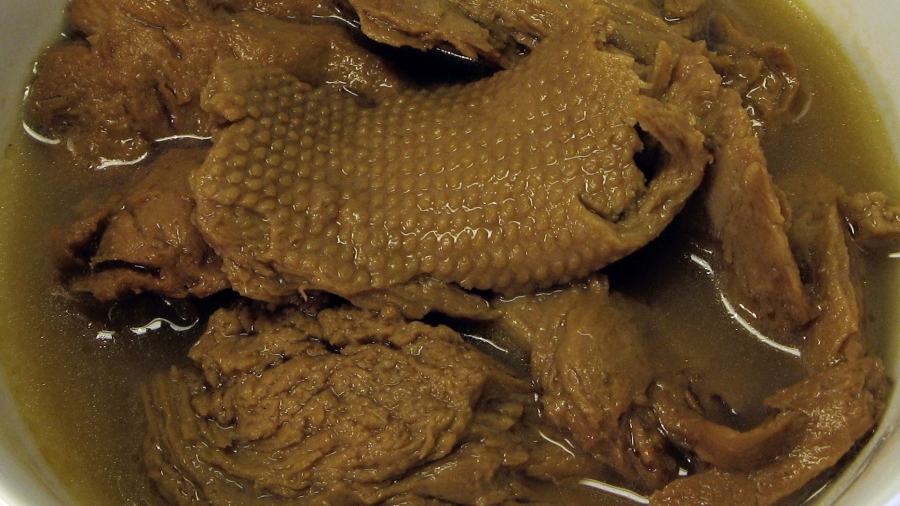I get blank stares when I ask my vegetarian cooking students if they’ve ever eaten seitan (say-tahn). Yet, hands go up when I ask if anybody has ever eaten mock chicken, beef, or pork in a Chinese vegetarian restaurant. The name is foreign but you may be more familiar with the product than you think.
According to Barbara and Leonard Jacobs in their excellent book Cooking with Seitan, The Complete Vegetarian “Wheat-Meat” Cookbook, “seitan has been a staple food among vegetarian monks of China, Russian wheat farmers, peasants of Southeast Asia, and Mormons. People who had traditionally eaten wheat had also discovered a method to extract the gluten and create a seitan-like product.”
Seitan is derived from the protein portion of wheat. It stands in for meat in many recipes and works so well that a number of vegetarians avoid it because the texture is too “meaty.”
Gluten can be flavored in a variety of ways. When simmered in a traditional broth of soy sauce or tamari, ginger, garlic, and kombu (seaweed), it is called seitan. I refer to all flavored gluten as seitan. Making gluten the traditional way is time consuming. It calls for mixing 8 cups of flour with 3 to 5 cups of water and forming a dough. The dough is then kneaded and rinsed under running water to remove the wheat starch. After about 20 to 30 minutes of kneading and rinsing, which to me seems like a considerable amount of time, the resulting 2 or so cups of stretchy gluten is evident. At that point the gluten needs to be simmered in broth for at least 1 hour and up to 2 hours or more.
Luckily there are some shortcut methods for making gluten (see recipe) that make it a convenient food to prepare. I have had the most luck using high gluten flour or vital wheat gluten, although I have found that until you become familiar with the texture you are aiming for during the mixing and kneading process, the results will vary somewhat.
The added benefit of using this method is that you can flavor the gluten during the kneading process by adding herbs and spices of your choosing other than the traditional ginger and garlic. You can use poultry seasoning or chicken flavor broth powder to make a “chicken” flavored seitan, or a blend with paprika, cayenne, fennel, garlic, and Italian seasoning for a “sausage” flavor. Flavoring is limited only by your imagination.
For some, a safer first step is to purchase one of the commercially available mixes. Arrowhead Mills’ Seitan Quick Mix or any of the Knox Mountain products, which include Wheat Balls, Chicken Wheat, and Not-So- Sausage, yield a tasty product. Just be sure to follow the box directions exactly.
Gluten containing more water or which has been kneaded less tends to get puffy instead of being dense. Some people prefer the less dense result. I like gluten to be quite firm, as it substitutes more easily for animal foods in recipes.
Commercially prepared seitan is produced by White Wave and Lightlife Foods as well as regional manufacturers. You will find it in tubs or vacuum packs soaking in marinade in either the refrigerator or the freezer section of many natural food stores. You may also find frozen or fresh gluten in Asian markets by the name Mi-Tan.
Gluten seems to be cropping up in more products these days and is often a key ingredient in “not-dogs.” Once made, seitan can be stored in broth in the refrigerator for up to about a week. Individually-wrapped cutlets can be frozen for up to a month or more without a loss in texture or flavor. It is best to thaw them before using.
Seitan’s versatility lies in the myriad forms it assumes during the cooking process. I find simmering to be the most effective and efficient preparation method. But it can be oven-braised, baked, cooked in a pressure cooker, or deep fried. Each version yields a different texture. Oven braising produces a texture similar to the chewy texture derived from simmering. Baking produces a light texture that works well when grinding or grating seitan. Pressure cooking, according to the Jacobs, “will produce a softer-textured seitan.” Fried gluten turns soft and slippery when cooked with a sauce and absorbs flavor well.
As gluten is a low sodium and extremely lowfat protein (containing around 10 mg. sodium, 0 g. fat, and 7.5 g. protein per ounce in its raw state), additional processing is what may add unhealthy attributes. Most of the commercially prepared seitan contains a considerable amount of sodium (up to 100 mg. per ounce). If you choose to deep-fry the gluten, the fat content will jump from virtually zero to the number of grams in whatever oil is absorbed (at 4.5 grams per teaspoon).
Making seitan and gluten will open up a new horizon for you in the world of vegetarian cooking. It is terrific in stir-fries and paired with noodles in Asian-style dishes, yet also works well in traditional American fare like stew. Try substituting it for animal products in former favorite recipes or those of non-vegetarian friends and relatives. Then get your creative juices flowing and experiment when making seitan by varying the flavorings and cooking methods.
Quick Homemade Gluten
(Makes 1-1/4 to 1-1/2 pounds or 2 to 2-1/2 cups)
This is the basic recipe for gluten.
2 cups gluten flour
1 teaspoon garlic powder
1 teaspoon ground ginger
1-1/4 cups water or vegetable stock
3 Tablespoons lite tamari, Braggs liquid amino acids, or soy sauce
1-3 teaspoons toasted sesame oil (optional)
Add garlic powder and ginger to flour and stir. Mix liquids together and add to flour mixture all at once. Mix vigorously with a fork. When it forms a stiff dough knead it 10 to 15 times.
Let the dough rest 2 to 5 minutes, then knead it a few more times. Let it rest another 15 minutes before proceeding.
Cut gluten into 6 to 8 pieces and stretch into thin cutlets. Simmer in broth for 30 to 60 minutes.
Broth:
4 cups water
1/4 cup tamari or soy sauce
3-inch piece of kombu (a type of seaweed)
3-4 slices ginger (optional)
Combine all ingredients in a large saucepan. Bring broth to a boil. Add cutlets one at a time. Reduce heat to barely simmer when saucepan is covered. Seitan may be used, refrigerated, or frozen at this point.
Total Calories per 4 oz. Serving: 77
Fat: 0 grams
Written by: Jill Nussinow, M.S., R.D. from The Vegetarian Resource Group
For Seitan recipes click here



Add a Comment